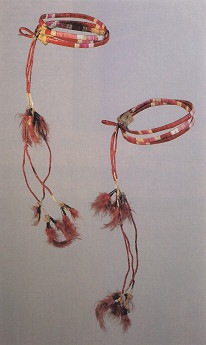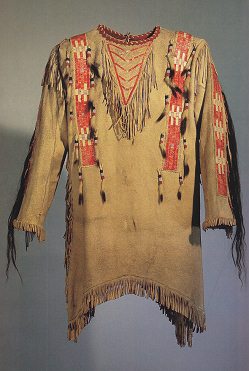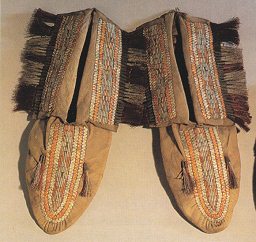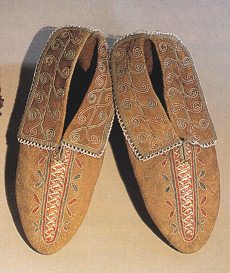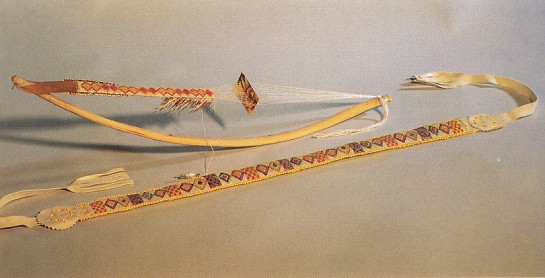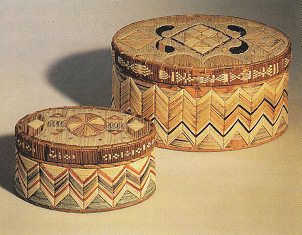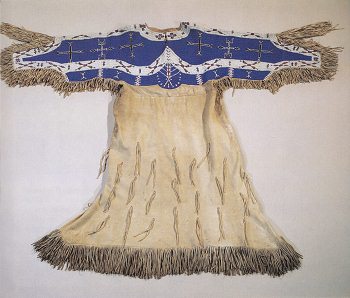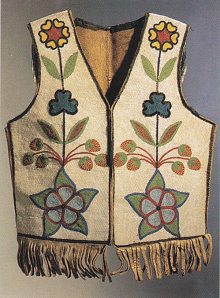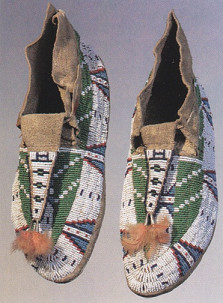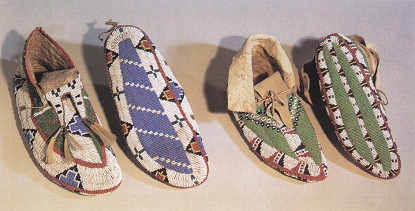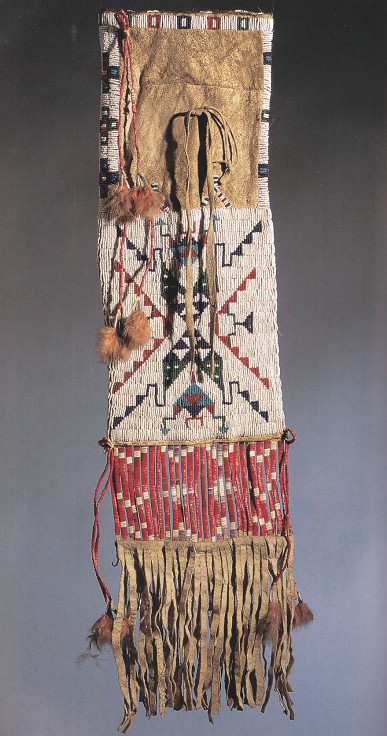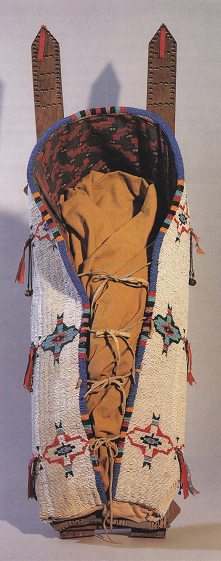|
|
|
North "American" Primary Nations Museum (North America Native Museum) Zurich
6. Quillwork with softened porky bristles - beading work with European glass beads
Sioux feather of honor with enforced feather quill, a hard leather strap with quill wrapped around it
Velvet cap with beading work of Iroquois primary nation
presented and translated by Michael Palomino (2012)
Share:
|
|
|
from:
Prestel museum guide, text by Denise Daenzer and Tina Wodiunig: Native Museum of Zurich (orig. German: Indianermuseum Zürich / Indianermuseum der Stadt Zürich); Prestel edition; Munich, New York 1996; supported by Cassinelli Vogel foundation, Zurich, by MIGROS percent for culture, by Volkart foundation in Winterthur; ISBN 3-7913-1635-4
<Quillwork and beading work
[First ornamental techniques with natural resources]
First techniques of ornamental works fixing three-dimensional ornaments on skins, leathers and other pads was developed in native cultures first with very natural materials and in very different ways. The origin materials for ornaments and jewelry were porky bristles, elk hairs, peals, snail shells, feathers, feather quills, grasses, straw or teeth from different animals. By commercial relationships with European imperialists and immigrants in later times also glass beads, velvet straps and colored fabrics were applied for ornaments. Partly the techniques were copied from the whites, but partly also own techniques were developed in combination with traditional native handicraft techniques. Very special native handicraft was considered by the Europeans as for example ornamented pipe bags (picture p.74), saddlebags and hunting bags, and also beaded clothes, leggings and moccasins with geometric and flower ornament designs.
[Quillwork with softened and colored porky bristles and natural colors]
Examples of quillwork with softened and colored porky bristles
Quillwork is the application of porky bristles and was known first in the northern forest areas and in subarctic zones. Later more native groups came to the forest areas spreading the technique also in prairie areas. The dwellers of the Plains also got to know this technique and provided the well loved ornament bristles by exchange trade or by hunting expeditions to the northern regions. Hunting of porkies was men's task, working with the bristles and all the quillwork was women's domain.
Softening the bristles for an ornament application was performed deposing them into warm water or softening them in the mouth. Mostly the bristles also were colored - well loved were red, yellow or black. As colors plants and minerals were used. Getting strong colors was reached by cutting the bristles at their ends so also the inner tube of the bristle was colored. Only since the end of 19th century also European aniline colors were used.
There are very different quillwork techniques, wrapping, plaiting, sewing and weaving, and there are many variations depending on culture and region.
[Quillwork technique of wrapping]
Most simple method was wrapping as it is shown with the two arm bands of Oglala Sioux primary nation (photo 5). There was (p.85) a raw leather strap parted into three straps remaining a common end, and these straps were wrapped with white, red and rose bristles. On the back they were fixed by sticking them. Such wrapped straps also were composed to big designs as it's shown with the scalp shirt (photo 1).
Wrapped quillwork with armbands or scalp shirt
Quilled armbands were put on upper arms of men during dances and ceremonies.
This softly tanned leather shirt is ornamented with quillwork straps at it's arms and shoulders with. The front is also ornamented with ermine tails. The back is ornamented with locks of a scalp.
[Quillwork technique of plaiting]
Plaiting quillwork was performed with flattened bristles plaited under and over two tendon threads up to creating a strap with a plaiting design that was formed by two combined triangles. When there was plaiting work with two different bristles at the same time, so a rhombus formed design was created. For especially fine plaiting quillwork soft and thin bristles of the belly side of a porcupine were used. Add to this a one thread technique was preferred wrapping a quillwork strap around a thread sewing it on the pad in same distances. By this living lines were created above all typical for the curve designs of Iroquois primary nation (photo 4).
Plaited quillwork in moccasins
Moccasins with soft sole. On the upper side (instep) and at the sides can be seen a fine quillwork in broad straps in triangle band technique. At the sides there are red and white stag hair bundles fixed with tendon threads and plate capsules.
x
The leather is colored brown by smoke. Quillwork applications are in lines and in three bands. Velvet margins of the borders are ornamented with white pearls.
[Quillwork technique of weaving]
This weaving quillwork technique was only applied by some groups in subarctic climate. There was used a wooden weaving bow with many threads fixed at the two ends (photo 2). The bristles were plaited into the threads so a beautiful ribbon was worked out. At the end the bristles will be cut and covered by a leather or fabric strap.
The wooden bow is stringed with an initial quillwork weaving. There are shown three steps: the first part is already finished and fixed borders and a leather at the bottom; the second part in the middle has cut bristles; and the last part has got it's complete bristles yet. There is a quillwork belt added in the photo. Today woven quillwork is rare. This belt is relatively new and was woven by Rosa Minoza in Fort Providence (Great Slave Lake).
Women native in the region of the Great Lakes ornamented also their boxes made of birch bark with porky bristles (photo 3). The bristles were sticked into pre-drilled holes, then the bristles were curbed to the inner side and covered and kept by another bark as a lining.
After sticking the bristles into the pre-drilled holes, the tops of the bristles were curbed and conceals by another birch bark as a lining.
[Glass beads releaving mainly the time-consuming work with porky bristles - product range of glass beads of the chief]
During 19th century commerce with European glass beads was winning more and more significance so the time-consuming quillwork technique was more and more alternated. Some kind of pearls were produces by natives in pre Columbian times already working with seashells and snail shells (comp. photo 8 on p.61) fixing them on clothes or making necklaces of them. But beading technique was spread all over the continent by exchange commerce with Europeans only. And in a short time beads became a symbol of welfare, and a chief was not rated well when he had no great product range of beads with a value of at least two hundred furs.
Examples for beading works of primary nations
[The stitched "America" flags are cynicism and adoption to the power of imperialist orientated fire arms].
Blue color on womens and girls clothes of Sioux was many times not representing the blue of the sky, but could be also a symbol for the earth - probably because of blue potter's earth in Minnesota. Sioux won their blue color from this earth.
This vest with beading ornaments (overlay stitch) is a copy of white men's clothes who often were working open air in clothes without sleeves. The flower design is characteristic for forest dweller primary nations of North East.
For the burial the dead body was wrapped into precious clothes, and the moccasins for the dead were also worked in beading technique on the sole because there was the idea that the dead was stepping to the beyond passing Milky Way.
[Glass beads imported from Amsterdam, Gablonz (Bohemia) and Venice area (Murano)]
The well wanted glass beads were produced in Amsterdam, in Bohemian Gablonz and above all in Venice area in Murano. Until today Venice is rated in America as the "Mother of Modern Beads". From there came the famous "trade heads" as Chevron beads, Cornaline d'Aleppo beads and all the other lamp beads. Aside of "trade beads" there were also well loved and famous "crow beads", "pony beads" and "seed beads". But only the tiny "seed beads" with not more than three millimeters of diameter (called Rocailles in Europe) enabled the filigree bead work as it can be seen for example on the leather gloves (photo 7) (p.86).
[Two beading techniques]
Working with glass beads was mainly performed in two different techniques: weaving on a wimple weaving frame and stitching on fabric, leather and on other materials. The designs were copied first from quillwork technique, and later more native designs and European motives were added resulting new designs and forms (photo 6). Add to this there were kinds of beading stitching every little bead for itself on the pad, or there were other beading techniques fixing many beads on one single threat and fixing this bead threat with a second threat in regular distances. This "overlay" technique was mainly performed by natives of Northern Forest Land for their jewelry with flower designs (photo 9).
When there were whole surfaces to cover in beading technique, the women of Plains and Prairie areas used the "lazy stitch" fixing five to ten parallel rows of beads by a second threat. In this way the characteristic bow and stud designs came out (photo 12).
[Emancipation with quillwork and beading work - also men do it]
As quillwork and beading work was only for women before, times were changing when there was a high demand for these beading objects by renaissance of powwows and other native traditions, and also tourist market provoked more demand for native handicrafts. Therefore also more and more men are ready to do beading works (p.87).




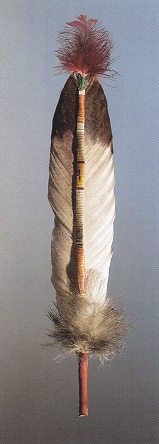
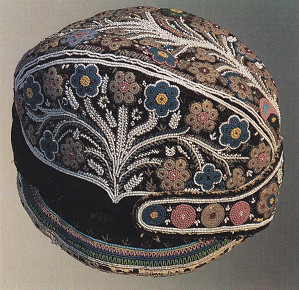
 Sioux
feather of honor with enforced feather quill,
a hard leather strap with quill wrapped around
it (from the feather's chapter). This feather
is also ornamented with two down feathers at
the top and at the bottom.
Sioux
feather of honor with enforced feather quill,
a hard leather strap with quill wrapped around
it (from the feather's chapter). This feather
is also ornamented with two down feathers at
the top and at the bottom.
